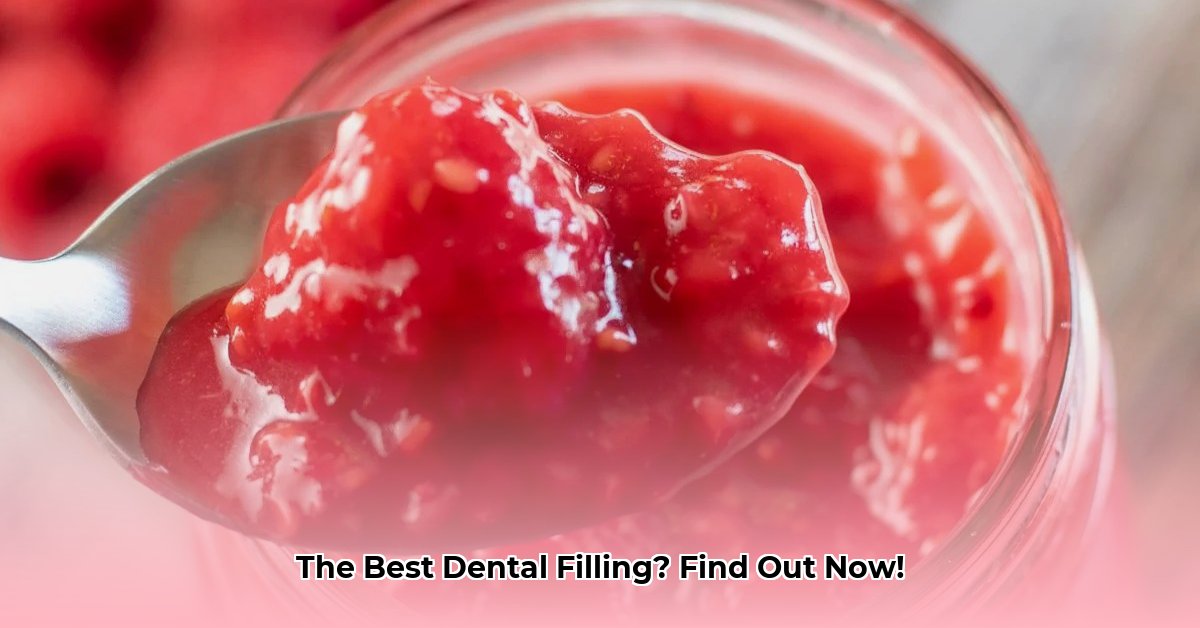Picking the right filling for a cavity can be tricky! There are lots of choices – some shiny, some match your teeth perfectly, and some are super strong. This guide breaks down the pros and cons of each type, so you can talk to your dentist like a pro and get the best filling for your smile and your budget. We’ll cover how long each type lasts, how much they cost, and how they look, so you can make the best decision for your mouth. Want to know what you can eat afterwards? Check out this helpful guide: Eating after a filling.
Filling Better: Your Guide to Choosing the Right Dental Filling
Picking the perfect dental filling can feel like navigating a minefield, especially with the variety available. Understanding your options is the first step to getting the best results. This guide breaks down the most common types, helping you work with your dentist to find the perfect fit for your dental health.
Amalgam Fillings: The Tried and True Dental Restorations
Amalgam fillings, often called “silver fillings,” have been a go-to for dentists for ages. They’re incredibly durable, lasting a good 10 to 15 years or even longer. Think of them as the reliable workhorses of the dental world – tough and dependable. However, they’re not the prettiest option, standing out more than other fillings. This makes them a better choice for the back teeth, where appearance isn’t as much of a concern for dental patients. Some people worry about the mercury content, but leading dental organizations like the FDA (Food and Drug Administration) and ADA (American Dental Association) confirm that they’re safe for adults and older children. These fillings typically consist of about 50% mercury, along with a mixture of silver, tin, copper, and zinc.
Composite Resin Fillings: A Versatile Choice for Dental Care
Composite fillings are the chameleons of the dental world. They’re tooth-colored, meaning they blend seamlessly with your natural teeth, making them a popular pick for visible front teeth. They bond directly to your tooth, creating a smooth, natural-looking repair. Plus, they’re less invasive than some other options, meaning less drilling. However, their lifespan is shorter than amalgam, usually five to ten years, so consider this for long-term restorative dentistry. Think of them as the reliable everyday car—efficient, practical, and well-suited for most needs. These fillings are made from a resin and plastic material that is placed into the cavity while it’s soft, then hardened with a bright blue “curing” light. While generally durable, staining from coffee, tea, or smoking can occur over time.
Ceramic Fillings: The Premium Choice for Dental Aesthetics
If you prioritize aesthetics above all else, ceramic fillings, often made from porcelain, are a top contender. They’re incredibly lifelike, mimicking the natural look of your teeth with exceptional precision. Expect a longevity comparable to amalgam fillings—15 years or more—but with far superior aesthetics for cosmetic dentistry. They’re tough, but can be slightly more susceptible to chipping than other options. This is the luxury car of dental fillings – superior aesthetics, and durability, but with a higher price tag from most dental practices. Ceramic fillings are also biocompatible, reducing the risk of allergic reactions.
Gold Inlays/Onlays: The Gold Standard (and Price) for Lasting Dental Solutions
Gold fillings are the undisputed champions of longevity, often lasting an impressive 20 years or more in restorative dentistry. Their biocompatibility—meaning they don’t cause allergic reactions—and durability are exceptional. However, their high cost and noticeable gold color usually limits their use to specific cases. Think of them as the investment property of dentistry. Gold fillings are typically made from an alloy of gold with other metals, such as copper and silver, to increase their strength and durability. The procedure for placing gold fillings usually requires multiple dental visits.
Glass Ionomer Fillings: The Fluoride Powerhouse for Preventive Dental Care
Glass ionomer fillings are unique because they release fluoride, which helps strengthen your teeth and protect against future cavities. This is particularly beneficial in areas prone to decay and for children. However, they don’t last as long as other options, often needing replacement within five years or less. They are more suited to specific situations where the fluoride-releasing properties are prioritized in dental treatments. Glass ionomer fillings are made of a combination of glass and acrylic. They bond chemically to the tooth, which can help to reduce sensitivity.
Making the Right Choice: Factors to Consider for Optimal Dental Health
Choosing the “best” filling is a highly personalized decision. It’s a conversation you need to have with your dentist. Consider these key factors for selecting dental filling materials:
- Budget: Amalgam is the most affordable option; gold and ceramic are the most expensive.
- Longevity: Amalgam and gold fillings offer the longest lifespan.
- Appearance: Composite and ceramic fillings offer the most natural look.
- Location: Amalgam may be suitable for molars, while composite or ceramic are ideal for front teeth.
- Allergies: Consider any known allergies to metals or resins.
- Bite Strength: Areas with heavy bite forces may benefit from stronger materials like amalgam or gold.
- Overall Oral Health: Existing dental conditions can impact filling choice.
It is also important to note that proper maintenance significantly contributes to the lifespan of any dental filling!
Tips for Longer-Lasting Fillings and Optimal Oral Hygiene
The lifespan of your filling depends significantly on your care. Here’s how to maximize its life:
- Practice impeccable oral hygiene: Brush twice daily with fluoride toothpaste and floss regularly.
- Visit your dentist regularly: Catching problems early prevents larger, more costly issues down the line. Regular checkups allow your dentist to identify and address any potential problems with your fillings early on.
- Avoid hard candies and ice: These can chip or crack your fillings and compromise tooth structure.
- Open communication with your dentist: Discuss your expectations, concerns, and budget so you can make an informed decision together!
- Consider a nightguard if you grind your teeth: Grinding can put excessive pressure on fillings, leading to premature wear or damage.
- Be mindful of acidic foods and drinks: Frequent exposure to acids can erode tooth enamel and weaken fillings.
The Future of Dental Fillings and Advanced Restorative Options
The search for the “perfect” filling continues. Researchers are constantly developing new materials that promise even greater strength, durability, and aesthetics. These advancements likely hold even better options for the future of modern dentistry. Bioactive materials that release minerals to promote tooth remineralization are one area of ongoing research. By working closely with your dentist, you can benefit from the best currently available options while staying informed about upcoming innovations.
How to Choose the Best Dental Filling Material Based on Tooth Location
Choosing a suitable filling material involves careful consideration of factors like cost, aesthetic preference and potential allergies, with aesthetic preference in dental procedures being a crucial aspect! Furthermore, the location of the tooth plays a significant role in deciding which material is best suited.
Understanding Your Fillings Options: A Material Showdown
So, you need a filling. But with so many options, how do you choose the best dental filling material based on tooth location? Let’s break it down. Think of it like choosing the right tool for a job – a hammer for nails, a screwdriver for screws. Similarly, different fillings are better suited for different areas in your mouth.
Amalgam: The Workhorse for Posterior Teeth
Amalgam, a mix of metals including mercury, has been a dental staple for decades. It’s incredibly strong and durable, making it ideal for high-stress areas like your back teeth – those molars that do the heavy chewing. It’s also relatively inexpensive. However, its dark color makes it unsuitable for visible front teeth. And while the American Dental Association deems it safe, some patients have concerns about mercury. The material’s high compressive strength makes it ideal for areas that undergo significant chewing forces. Amalgam fillings are often used in larger restorations where strength is paramount.
Composites: The All-Arounders for Versatile Dental Restorations
Composite fillings are tooth-colored, making them aesthetically pleasing. They are versatile, generally suitable for both front and back teeth, though their durability might be slightly lower than amalgam in high-stress areas. They require precise placement, and the exact composition significantly impacts their longevity and appearance over time. Composite fillings are a good choice for small to medium-sized restorations.
Ceramic: The Beauty Queens for Front Teeth
Ceramic fillings, often made from porcelain, offer exceptional aesthetics. They closely match the natural color of your teeth, making them perfect for front teeth to enhance your smile. Their durability is comparable to composites, though they’re generally more expensive due to the materials and expertise required for placement. Ceramic inlays and onlays can also be used for larger restorations, providing both strength and aesthetics.
Gold: The Ultimate in Durability (but pricey!) for Dental Work
Gold fillings are the gold standard (pun intended!) when it comes to longevity among dental filling materials. Extremely durable and resistant to wear and tear, they far outlast other options. However, their high cost and noticeable color make them a less common choice in cosmetic dentistry. Gold inlays and onlays are typically used for back teeth where strength is essential.
Glass Ionomer: A Specialized Solution for Specific Dental Needs
Glass ionomer fillings are used in specific situations, such as near the gum line where they release fluoride, protecting the tooth from decay. They aren’t as durable as other options
- Gluten Free Meal Prep Ideas for Delicious, Hassle-Free Eating - November 28, 2025
- Gluten Free Meal Prep for Stress-Free and Healthy Eating - November 27, 2025
- Quick And Easy Chicken Thigh Meal Prep For Weight Loss - November 26, 2025










